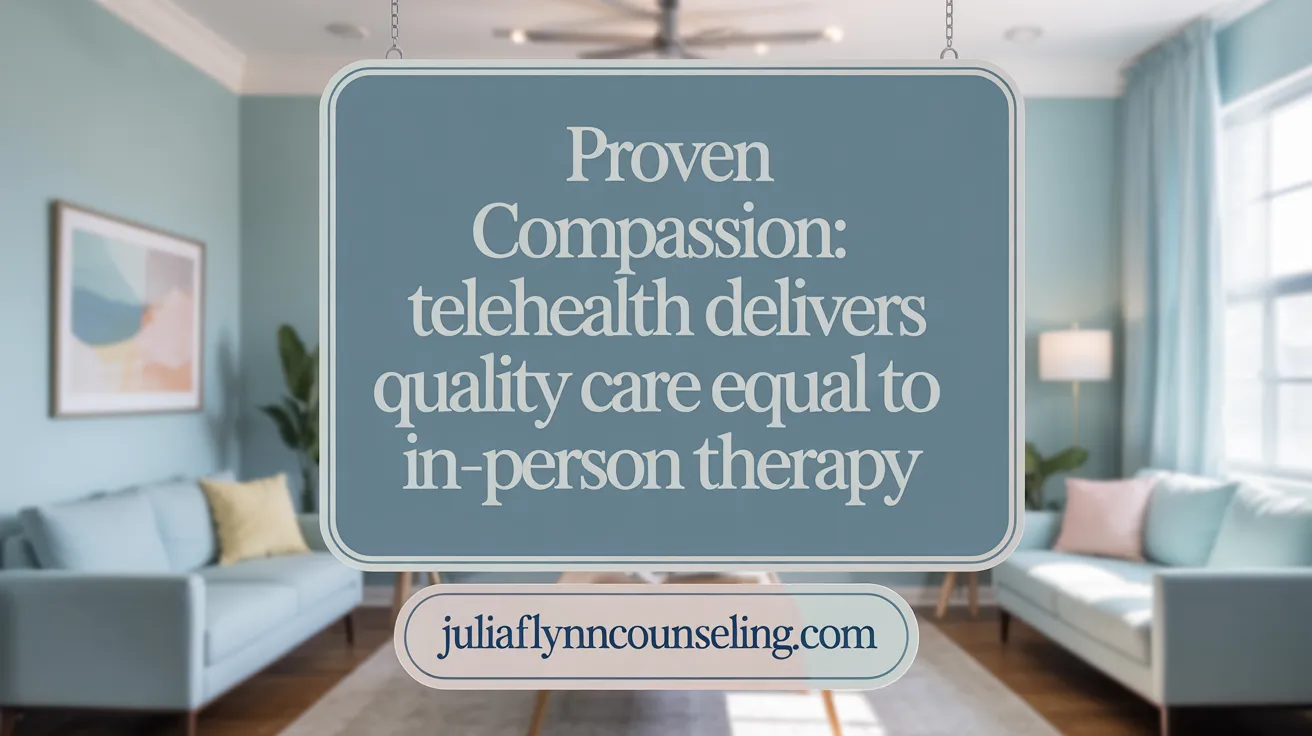Introduction to Telehealth Counseling in Modern Mental Health Care
Understanding Telehealth Counseling
Telehealth counseling refers to the delivery of mental health services using digital technologies, enabling remote communication between clients and clinicians. This approach uses tools such as video calls, phone sessions, emails, and secure messaging platforms.
Rapid Growth Since the Pandemic
The COVID-19 pandemic accelerated the expansion of telehealth, with usage surging by over 150% during early 2020. This shift allowed continuous care while following social distancing measures and has since become a routine part of mental health service delivery.
Key Digital Tools
Common digital platforms facilitating telehealth counseling include HIPAA-compliant video conferencing apps, mobile health applications, and interactive online portals. These resources support therapy sessions, assessments, and ongoing monitoring.
Impact on Accessibility and Convenience
Telehealth has significantly improved access to mental health care by removing geographical and transportation barriers. It offers flexible scheduling, reduces stigma by allowing clients to engage from private spaces, and provides the comfort of receiving care in familiar environments, thereby enhancing treatment engagement and continuity.
Expanding Access and Overcoming Barriers Through Telehealth

How does telehealth increase access to mental health services?
Telehealth uses digital platforms to deliver mental health care remotely, breaking down traditional barriers such as geographic distance and limited local provider availability. It connects clients and clinicians through video, phone, apps, and online messaging, enabling timely and continued care regardless of location. This technology-driven approach effectively serves rural and underserved populations who otherwise face difficulties reaching mental health services.
What are the benefits for rural, underserved, and mobility-limited populations?
Telehealth removes transportation barriers and reduces travel time, making it easier for people with limited mobility or those living in remote areas to access therapy. It also serves communities experiencing shortages of qualified mental health clinicians. Services can be delivered directly to patients’ homes, increasing treatment continuity and reducing no-shows. Additionally, telehealth expands access to culturally competent providers critical for underserved populations (Telehealth in mental health care).
How does telehealth reduce privacy concerns and stigma?
Receiving care from home increases privacy and discretion, which reduces stigma often associated with seeking mental health support. Telehealth allows individuals to engage in therapy sessions without the worry of being seen entering a clinic, fostering a safer, more comfortable environment to discuss sensitive issues (Privacy in teletherapy).
What impact does telehealth have on wait times and scheduling flexibility?
By expanding the available pool of providers outside one's immediate geography, telehealth shortens waiting periods for appointments. It offers flexible scheduling options, such as early morning, evening, or weekend sessions, accommodating clients’ busy lives and improving adherence (Benefits of Online Therapy).
What advantages does telehealth provide for specific populations?
- Children and adolescents: Telehealth enables school-based services and engaging virtual activities, decreasing missed school days and easing family involvement (Telehealth appointments for mental health).
- Older adults: Adaptations like clear communication and user-friendly platforms help overcome technological and sensory challenges (Telehealth for mental health care.
- LGBTQIA+ individuals: Inclusive language and affirming care practices can be more readily accessed via telehealth, fostering a supportive experience (Telehealth for mental health care.
Through these benefits, telehealth is playing a pivotal role in making mental health care more accessible, flexible, and acceptable, especially for groups traditionally facing barriers to treatment (Benefits of Telehealth).
Effectiveness and Quality of Care Delivered via Telehealth

How does telehealth compare with in-person therapy in effectiveness?
Research consistently shows that telehealth for mental health care offers effectiveness comparable to traditional face-to-face therapy. Studies, including large randomized clinical trials, have found that telehealth interventions lead to similar improvements in patient quality of life, symptom management, and satisfaction as in-person treatment. Conditions such as depression, anxiety, PTSD, panic disorder, and social anxiety disorder respond well to teletherapy approaches.
What types of therapy are well-suited to telehealth?
Various evidence-based therapies adapt effectively to telehealth, including Cognitive Behavioral Therapy (CBT), family and marital therapy, solution-focused therapy, and Jungian therapy. Both synchronous video sessions and asynchronous modalities (like apps and mood tracking) facilitate flexible delivery. Emergency consultations, medication management, and psychotherapy can all be conducted remotely, allowing continuity of care.
What research supports positive patient outcomes with teletherapy?
Meta-analyses and controlled studies demonstrate high rates of patient adherence, satisfaction, and clinical improvement across multiple telehealth modalities. Remote mental health care has been shown to reduce symptom severity and promote functional recovery. Approximately 60% of telehealth users report improvements after just a few sessions. Telepsychiatry enhances access and treatment continuity, particularly benefiting underserved and rural populations.
How do patients respond to telehealth in terms of satisfaction and engagement?
Many patients appreciate the convenience, privacy, and comfort of receiving therapy from home. Telehealth reduces stigma and allows more relaxed, open communication. Virtual platforms enable flexible scheduling and decrease travel burdens, increasing adherence and timely access. Patient satisfaction remains high with well-supported telehealth programs, often equaling in-person care.
What are the important challenges and safeguards in telehealth mental health care?
Challenges include technical difficulties such as unstable internet connections and access issues. Privacy and confidentiality are paramount; thus, secure, HIPAA-compliant platforms with encryption are utilized. Providers carefully establish trust and maintain rigorous protocols to protect client information. Some limitations in observing non-verbal cues exist but are managed with skillful engagement and communication techniques.
| Aspect | Details | Notes |
|---|---|---|
| Effectiveness | Comparable to in-person | Supported by extensive research |
| Therapy Types | CBT, family therapy, telepsychiatry | Adaptable to synchronous and asynchronous use (modes) |
| Outcomes | High satisfaction and clinical improvement | 60% report improvements early on (data) |
| Patient Satisfaction | Enhanced privacy, comfort, flexibility | Reduces stigma and travel burden (benefits) |
| Challenges | Technical, privacy concerns | Mitigated by secure platforms and training |
Technological Innovations and Tools Enabling Telehealth Counseling

What technologies are used in telehealth counseling?
Telehealth counseling employs a range of technologies to connect patients and providers remotely. Videoconferencing platforms enable live video sessions, providing interaction similar to face-to-face therapy. Mobile apps and secure messaging systems offer additional communication channels for text, chat, and asynchronous support.
How do telehealth platforms ensure privacy and compliance?
Telehealth counseling platforms are designed to comply with HIPAA Compliance in Telehealth regulations, using encrypted and secure channels to protect patient confidentiality. Many platforms include features such as password protection, secure login, and data encryption to guard sensitive health information.
What digital adjuncts support telehealth?
Advanced tools enhance telehealth counseling, including AI-driven mood tracking apps that monitor mental health symptoms in real-time. Virtual environments and internet-based games are incorporated to engage patients creatively. These digital aids complement therapy by allowing continuous monitoring and personalized interventions.
How is remote monitoring integrated with health records?
Wearable sensors and mobile devices collect health data like heart rate and sleep patterns, transmitting them securely to clinicians. Integration with electronic health records (EHR) allows seamless communication and coordinated care across providers.
What challenges do telehealth technologies face?
Internet connectivity remains a critical challenge, especially in rural or underserved areas with limited broadband access. Digital literacy also affects users’ ability to navigate platforms effectively, creating barriers for some populations. Ongoing efforts aim to improve infrastructure and offer user training to mitigate these issues.
Telehealth Counseling in Practice: Client and Provider Perspectives

How Does Telehealth Enhance Client Convenience and Comfort?
Telehealth counseling allows clients to attend sessions from the comfort of their own homes, which can significantly reduce stigma and anxiety often associated with visiting a therapist’s office. This home-based telehealth care setting promotes increased openness and privacy, enabling clients to discuss sensitive issues more freely. Flexible scheduling options further accommodate busy lifestyles, allowing clients to fit therapy into early mornings, evenings, or other non-traditional hours (Convenience of teletherapy.
What Flexibility and Expansion Opportunities Do Providers Experience?
Providers benefit from telehealth by gaining greater scheduling flexibility and the ability to expand their practices beyond geographic limitations. This technology enables outreach to underserved or rural populations who might otherwise lack access to specialized mental health services. Remote therapy reduces travel-related time and costs for providers, contributing to improved work-life balance and the potential to serve larger caseloads (Benefits of telehealth for providers).
How Is Privacy Maintained in Telehealth Counseling?
Privacy considerations are paramount in telehealth. Licensed practitioners utilize HIPAA Compliance in Telehealth compliant, encrypted platforms to conduct secure sessions. Clients are advised to select quiet, private spaces for their sessions and to use secure personal devices. Extra care is taken to maintain confidentiality, and providers often discuss privacy protocols and consent at the start of therapy to reassure clients (Privacy in telehealth).
What Are the Challenges in Building Rapport and Managing Crises Remotely?
Building trust and rapport in virtual settings requires deliberate engagement, including maintaining eye contact and attentive communication. Providers face challenges in nonverbal cue recognition and managing emergencies, such as suicidality or abuse, remotely. Safety planning and clear crisis protocols are essential components of telehealth practice to ensure client well-being (Telehealth client safety and risk assessment.
What Insights Do Licensed Practices Like Julia Flynn Counseling Offer?
Julia Flynn Counseling Psychology exemplifies a licensed practice delivering telehealth with a personalized approach. Through a secure, HIPAA-compliant platform, Julia offers individual, couples, and family therapy tailored to client needs, emphasizing evidence-based therapies such as Cognitive Behavioral Therapy. The practice highlights the importance of collaborative treatment planning, insurance flexibility, and smooth online access to ensure client comfort and continuity of care (licensed therapist Julia A Flynn).
This combination of client-centered convenience, provider adaptability, and stringent privacy measures illustrates why Telehealth Counseling Platforms is becoming a vital component of modern mental health care, despite the challenges it presents (Telemental Health Care).
Future Directions and Policy Considerations in Telehealth Mental Health Care
What are the latest regulatory and licensing developments in telehealth mental health care?
Efforts to streamline licensing across state lines, such as the Counseling Compact for interstate practice, aim to facilitate interstate telehealth practice once enacted broadly. These developments promise to reduce barriers for practitioners and expand patient access beyond geographic restrictions. For additional insights on telehealth licensing and regulatory frameworks, see Telehealth legal and regulatory issues.
How is insurance reimbursement evolving for telehealth mental health services?
While insurance reimbursement has expanded, especially during and after the COVID-19 pandemic, challenges remain. There is growing support for Medicare and Medicaid telehealth reimbursement, but variability in policies and lower reimbursement rates continue to impact widespread provider participation and sustainability. More on reimbursement challenges and policy updates can be found in Telehealth insurance challenges.
What is the role of hybrid care models in the future of mental health services?
Hybrid models that integrate telehealth with in-person visits are gaining support from both patients and providers. Such models offer flexibility, helping tailor care to individual needs while maintaining continuity and personal connection when needed. Explore further trends in Telemedicine trends 2025.
How are equity and inclusion being addressed in telehealth mental health?
To reduce disparities, targeted efforts include expanding broadband infrastructure for rural areas, adapting platforms for disabilities and language needs, and promoting culturally sensitive services for marginalized groups, including older adults and LGBTQIA+ populations. For more information, see Telemental health equity, inclusion, and access.
What technological and clinical innovations are anticipated?
Innovations like AI-assisted symptom monitoring, mental health chatbots, and improved interoperability with electronic health records are shaping more personalized and efficient care. These advances also support remote monitoring and predictive analytics to enhance treatment. Learn more about technological advances at Telehealth technology and remote healthcare.
Telehealth is poised to remain an essential component of mental health care with ongoing policy, technological, and clinical advancements focused on access, quality, and inclusivity.
Conclusion: Telehealth Counseling as a Vital Component of Modern Mental Health Care
Telehealth counseling has become an essential part of modern mental health care, offering numerous benefits such as increased access, flexibility, and convenience.
It breaks down barriers related to geography, stigma, and mobility, allowing more people—especially those in rural or underserved areas—to receive timely, effective mental health support.
Despite challenges like technology access, privacy concerns, and regulatory complexity, telehealth continues to prove cost-effective and clinically comparable to in-person care.
Its role in enhancing equity and easing service delivery makes it invaluable for both patients and providers.
Ongoing innovation and adoption are encouraged to maximize telehealth's potential, ensuring comprehensive mental health care remains accessible and inclusive for all who need it.
